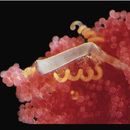en
names in breadcrumbs


(from Coe, W. R. (1905). Nemerteans of the west and northwest coasts of America. Bull. Mus. comp. Zool. Harv.. 1-318)
Parasitic nemerteans living on various species of crabs and sometimes other Crustacea. Body small, slender, filiform, rounded, and of about the same diameter throughout; head without distinct, lateral grooves. Body not coiled or twisted, but often folded sharply so that anterior portion of body lies parallel and in contact with posterior portion. Mouth and proboscis open together; esophagus extremely short, opening broadly into intestine through a large muscular chamber (stomach) situated immediately behind brain; intestine broad, with short; lateral pouches which are but little developed in posterior portion of body; pylorus and intestinal caecum practically wanting.
Proboscis sheath without muscular walls, consisting merely of a thin membrane closely applied to the small proboscis. Proboscis but little developed, very small in size, and extremely short, with out lateral pouches of reserve stylets, but armed with minute central stylet and basis only. Stylet region of proboscis can be withdrawn but little behind brain; consequently anterior chamber is very short, without distinct muscular layers, without distinct nerves, and without a thickened glandular epithelium such as occurs in almost all other nemerteans. Chamber immediately behind stylet, small but muscular, and with a lining of flattened epithelium, while posterior proboscidial cavity is very short, often almost spherical, highly glandular, connected closely with the rudiments of the proboscis sheath and imbedded in the connective tissue which lies intern al to the body musculature.
Cephalic glands massively developed; a remarkable development of submuscular glands extends throughout whole length of body, usually forming a distinct layer internal to the muscular walls of body, and often thicker than all other layers of body wall combined.
Cerebral sense organs probably wanting. Ocelli two; occasionally fragmented into four.
Usually oviparous, though fertilization often takes place internally, and sometimes a portion of the ova of an individual may be retained in the body until after the development of free-swimming embryos. Development without complicated metamorphosis.
Carcinonemertes is a genus of nemerteans belonging to the family Carcinonemertidae.[1]
The genus has almost cosmopolitan distribution.[1]
Species:[1]
Carcinonemertes is a genus of nemerteans belonging to the family Carcinonemertidae.
The genus has almost cosmopolitan distribution.